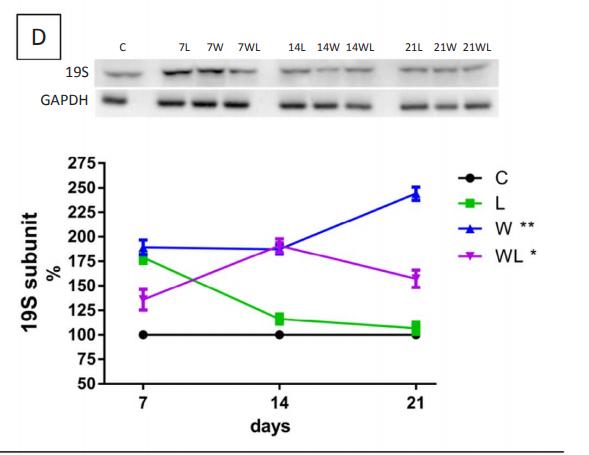PSMC4 Antibody - #DF6973
| 製品: | PSMC4 Antibody |
| カタログ: | DF6973 |
| タンパク質の説明: | Rabbit polyclonal antibody to PSMC4 |
| アプリケーション: | WB IHC |
| Cited expt.: | WB |
| 反応性: | Human, Mouse, Rat |
| 予測: | Pig, Zebrafish, Bovine, Horse, Sheep, Rabbit, Dog, Xenopus |
| 分子量: | 47kDa; 47kD(Calculated). |
| ユニプロット: | P43686 |
| RRID: | AB_2838929 |
製品説明
*The optimal dilutions should be determined by the end user. For optimal experimental results, antibody reuse is not recommended.
*Tips:
WB: For western blot detection of denatured protein samples. IHC: For immunohistochemical detection of paraffin sections (IHC-p) or frozen sections (IHC-f) of tissue samples. IF/ICC: For immunofluorescence detection of cell samples. ELISA(peptide): For ELISA detection of antigenic peptide.
引用形式: Affinity Biosciences Cat# DF6973, RRID:AB_2838929.
折りたたみ/展開
26S protease regulatory subunit 6B; 26S proteasome AAA ATPase subunit RPT3; 26S proteasome AAA-ATPase subunit RPT3; MB67 interacting protein; MB67-interacting protein; MIP224; Protease 26S subunit 6; Proteasome (prosome macropain) 26S subunit ATPase 4; Proteasome 19S S6; Proteasome 26S subunit ATPase 4; Proteasome 26S subunit, ATPase, 4; PRS6B_HUMAN; PSMC4; RPT3; S6; Tat binding protein 7; TAT-binding protein 7; TBP 7; TBP-7;
免疫原
A synthesized peptide derived from human PSMC4, corresponding to a region within C-terminal amino acids.
- P43686 PRS6B_HUMAN:
- Protein BLAST With
- NCBI/
- ExPASy/
- Uniprot
MEEIGILVEKAQDEIPALSVSRPQTGLSFLGPEPEDLEDLYSRYKKLQQELEFLEVQEEYIKDEQKNLKKEFLHAQEEVKRIQSIPLVIGQFLEAVDQNTAIVGSTTGSNYYVRILSTIDRELLKPNASVALHKHSNALVDVLPPEADSSIMMLTSDQKPDVMYADIGGMDIQKQEVREAVELPLTHFELYKQIGIDPPRGVLMYGPPGCGKTMLAKAVAHHTTAAFIRVVGSEFVQKYLGEGPRMVRDVFRLAKENAPAIIFIDEIDAIATKRFDAQTGADREVQRILLELLNQMDGFDQNVNVKVIMATNRADTLDPALLRPGRLDRKIEFPLPDRRQKRLIFSTITSKMNLSEEVDLEDYVARPDKISGADINSICQESGMLAVRENRYIVLAKDFEKAYKTVIKKDEQEHEFYK
種類予測
Score>80(red) has high confidence and is suggested to be used for WB detection. *The prediction model is mainly based on the alignment of immunogen sequences, the results are for reference only, not as the basis of quality assurance.
High(score>80) Medium(80>score>50) Low(score<50) No confidence
研究背景
Component of the 26S proteasome, a multiprotein complex involved in the ATP-dependent degradation of ubiquitinated proteins. This complex plays a key role in the maintenance of protein homeostasis by removing misfolded or damaged proteins, which could impair cellular functions, and by removing proteins whose functions are no longer required. Therefore, the proteasome participates in numerous cellular processes, including cell cycle progression, apoptosis, or DNA damage repair. PSMC4 belongs to the heterohexameric ring of AAA (ATPases associated with diverse cellular activities) proteins that unfolds ubiquitinated target proteins that are concurrently translocated into a proteolytic chamber and degraded into peptides.
Cytoplasm. Nucleus.
Belongs to the AAA ATPase family.
研究領域
· Genetic Information Processing > Folding, sorting and degradation > Proteasome.
· Human Diseases > Infectious diseases: Viral > Epstein-Barr virus infection.
参考文献
Application: WB Species: rat Sample: gastrocnemius muscle tissue
Restrictive clause
Affinity Biosciences tests all products strictly. Citations are provided as a resource for additional applications that have not been validated by Affinity Biosciences. Please choose the appropriate format for each application and consult Materials and Methods sections for additional details about the use of any product in these publications.
For Research Use Only.
Not for use in diagnostic or therapeutic procedures. Not for resale. Not for distribution without written consent. Affinity Biosciences will not be held responsible for patent infringement or other violations that may occur with the use of our products. Affinity Biosciences, Affinity Biosciences Logo and all other trademarks are the property of Affinity Biosciences LTD.


